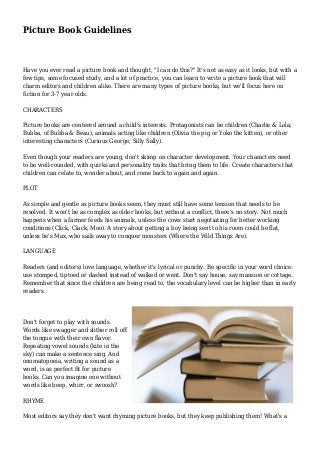
Picture Book Guidelines
- 1. Picture Book Guidelines Have you ever read a picture book and thought, "I can do this?" It's not as easy as it looks, but with a few tips, some focused study, and a lot of practice, you can learn to write a picture book that will charm editors and children alike. There are many types of picture books, but we'll focus here on fiction for 3-7 year olds. CHARACTERS Picture books are centered around a child's interests. Protagonists can be children (Charlie & Lola; Bubba, of Bubba & Beau), animals acting like children (Olivia the pig or Yoko the kitten), or other interesting characters (Curious George, Silly Sally). Even though your readers are young, don't skimp on character development. Your characters need to be well-rounded, with quirks and personality traits that bring them to life. Create characters that children can relate to, wonder about, and come back to again and again. PLOT As simple and gentle as picture books seem, they must still have some tension that needs to be resolved. It won't be as complex as older books, but without a conflict, there's no story. Not much happens when a farmer feeds his animals, unless the cows start negotiating for better working conditions (Click, Clack, Moo). A story about getting a boy being sent to his room could be flat, unless he's Max, who sails away to conquer monsters (Where the Wild Things Are). LANGUAGE Readers (and editors) love language, whether it's lyrical or punchy. Be specific in your word choice: use stomped, tiptoed or dashed instead of walked or went. Don't say house, say mansion or cottage. Remember that since the children are being read to, the vocabulary level can be higher than in early readers. Don't forget to play with sounds. Words like swagger and slither roll off the tongue with their own flavor. Repeating vowel sounds (kite in the sky) can make a sentence sing. And onomatopoeia, writing a sound as a word, is as perfect fit for picture books. Can you imagine one without words like beep, whirr, or swoosh? RHYME Most editors say they don't want rhyming picture books, but they keep publishing them! What's a
- 2. writer to do? First, realize they are generally speaking about the piles of manuscripts that are badly rhymed, because it is difficult to do it well. The meter must be perfect, the rhymes exact, and the lines written to advance the story, not just to make the rhyme work. The advice from editors and agents tends to be that if you can write it in prose, you have a much better chance of publication. But if you can't, be sure to read it aloud, and have it read and re-read by as many good critics as you can. If they stumble in a rough spot, you can be sure an editor will, too. ILLUSTRATIONS No, you don't have to be an illustrator to write a picture book. And you don't need to find one, either. The editor will judge your manuscript on its own merits, and when it is accepted, she will look for an illustrator to match your story. Editors often pair an unknown writer with an established illustrator to make the book easier to sell. LENGTH Picture books are short! Read them at the bookstore, and look at very current ones at the library. Over the last several decades, the word count has dropped tremendously. Most publishers are looking for picture books under 1,000 words, and 500 words is even better. Remember that a lot of description can be left out - that's the illustrator's job. Then cut and cut some more until what's left sounds like poetry. For a quick list of the differences between children's book age categories, read Writing for Children. http://suite101.com/picture-book-basics-a15198